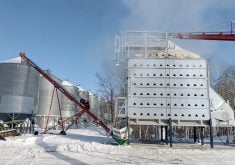‘What Vancouver has essentially become is a storage yard for empties,’ while Prince Rupert handles mainly non-ag goods
This year’s container crisis could get much worse if things aren’t fixed before the next crop comes in, according to a major container shipper.
“A perfect storm is brewing,” said Ray-Mont Logistics vice-president Stephen Paul during the Fields on Wheels conference last week. If a normal-sized crop is produced next summer and west coast ports are still clogged with loaded containers that can’t get out, exporting grain by container won’t be an option for most of the crop.
“I hope the import volume and the chaos subsides before then, but if it continues well beyond the summer, and the volumes increase on the grain side, it could be a fairly stressful experience come next year,” said Paul.
Read Also

Saskatchewan puts crown land auction on hold
Auctions of Saskatchewan crown lease land are once again on hold.
Fields on Wheels heard much about the troubling situation in Vancouver and other west coast ports, in which thousands of containers every week are being emptied of goods imported from Asia and then sent back across the Pacific empty, rather than being made available to be loaded with Canadian goods such as grain.
Asian-produced goods are in high demand by North American consumers and Asia shippers are willing to pay high premiums for containers. That makes it more lucrative for ocean freight companies to return empties to Asia rather than wait for a backhaul.
“Carriers are wanting to capitalize on what they see as an opportunity to make up for years of running in the red and being able to capitalize on the ability to make back… what they’ve lost in the past,” said Doug Mills of the Port of Vancouver.
It’s created a severe aberration in container flow.
“We saw the first time ever that there are more empties being exported out of the gateway than fulls,” said Mills.
“That’s not a good thing.”
Much of Canada’s pulse exports move by container, either loaded on the Prairies or at west coast ports, so it’s a particular problem for the pulse and special crops industry. It’s also a problem for many identity-preserved shipments.
The crisis has caused severe disruptions and restructuring of operations by companies like Ray-Mont. Paul said it has forced his company to slash its operations on the Pacific. In Vancouver, rather than running 24-7 with 90-100 staff exporting mostly agricultural goods, it is reduced to operating five days per week with 20 staff.
“What Vancouver has essentially become is a storage yard for empties,” said Paul.
The Prince Rupert facility in northern British Columbia is mainly handling non-agricultural goods these days.
“It’s completely changed,” said Paul.
The company doesn’t see the situation clearing up soon.
“We’re preparing for at least another 18 months of difficulties,” said Paul.
All along the west coast of North America, ports are clogged with exports that can’t get out by container. It’s become a bigger political issue in the United States than Canada, where “farm states” have much more influence, but no easy answers have been found. Many economists predicted the supply chain woes would be alleviated by early 2022, but most are now expecting the problems to linger into mid-year.
The small crop in Canada has blunted the impact of the container problems this year for farmers, although it has severely slowed many export shipments.
Paul said one planned shipment of 2,200 container units had to be sent out in tiny increments.
“We had boxes loaded, idled in our facility for up to six months,” said Paul.
“It really put pressure onto the system.”
Some exports have been sent through the eastern ports instead. Paul said Ray-Mont has boosted its operations and staff in Montreal to help move whatever exports can get out through the Atlantic.
“As the services have disappeared off the West Coast, customers have shifted their volume to the East Coast,” said Paul.
However, boosting volumes there has been difficult because of Montreal’s port’s constrictions. It also costs more to send shipments east if the customers are closer to west coast ports.
Whether the boost to agricultural container exports will remain out east is unclear.
“If Vancouver does normalize, the volume will go back,” said Paul.
“But if the Vancouver struggle continues, despite those rail rate differentials, Montreal will be the only viable option for a lot of these destinations and we will continue to grow,” said Paul.


















